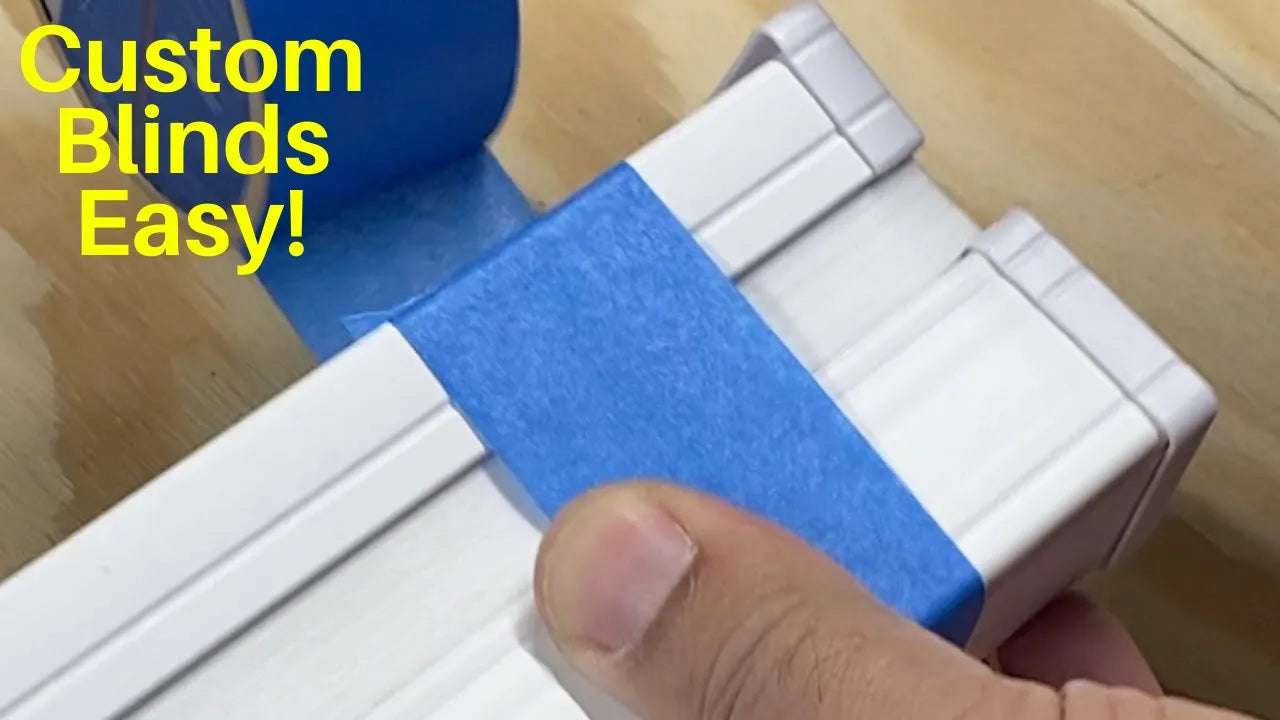How to Trim a Cordless Cellular Shade Easily

Learn how to trim a cordless cellular shade for your window and save money by doing it yourself. Follow these simple steps to customize the shade to fit perfectly.
The Art of Custom Window Treatments: Trimming Cellular Shades
How to Properly Measure for a Custom Cellular Shade?
When it comes to outfitting your home with the perfect window treatments, the details matter. Measuring your windows accurately is the key to ensuring a perfect fit for your custom cellular shades.
Accurate measurements are crucial when ordering custom-made cellular shades. Here's how to get it right:
- Measure the width of the window opening, leaving about a quarter-inch on each side. This extra space will allow the shade to fit snugly inside the frame.
- Take note of the height of the window opening as well, making sure to record the precise measurement.
- If your cellular shade is going to be installed inside the window frame, be sure to measure the exact dimensions of the opening. This will guarantee a seamless, professional-looking finish.
- Double-check all your measurements to avoid any costly mistakes when ordering your custom window treatment.
What Tools Do You Need to Trim a Cellular Shade?
Trimming a cellular shade to fit your window perfectly is a straightforward process, but it's essential to have the right tools on hand.
Here's what you'll need to get the job done:
- Sharp scissors or a utility knife
- Measuring tape
- Pencil
- Level (optional)
How to Trim a Cellular Shade for a Perfect Fit?
With your measurements in hand and the necessary tools ready to go, you can now tackle the task of trimming your cellular shade to fit your window opening.
Follow these steps for a flawless trim every time:
- Lay the cellular shade flat on a clean, sturdy surface.
- Using your measuring tape, mark the exact width you need to trim from each side of the shade.
- Carefully cut along the marked lines with your scissors or utility knife, making sure to keep the cuts straight and even.
- For the height, measure the window opening and mark the desired length on the cellular shade.
- Trim the top and bottom of the shade to the marked length, again ensuring clean, precise cuts.
- Double-check the fit of the trimmed shade in the window opening, making any final adjustments as needed.
With a little patience and the right approach, you can transform a custom-made cellular shade into the perfect window treatment for your home. By taking the time to measure accurately and trim carefully, you'll enjoy the beautiful, custom look you desire without the added cost of professional installation.
Transforming Window Shades: A Step-by-Step Guide
How Much Should I Trim Off the Shade?
When trimming a window shade, the amount you remove can make a big difference in the final result. The key is to carefully consider the size of your space and the desired outcome.
Determining the Perfect Fit
- If you're only taking off about an inch, it's best to trim from one side. This helps maintain the shade's symmetry and overall appearance.
- For larger adjustments of more than an inch, it's recommended to take a little bit from each side. This ensures a balanced and uniform look.
- Measuring the space and the shade carefully before cutting is crucial to achieving the perfect fit.
Preparing the Shade for Cutting
To ensure a clean, professional-looking cut, it's important to properly prepare the shade before using the miter saw.
Securing the Shade
- Using blue painter's tape, wrap the shade tightly to keep it in place during the cutting process.
- Wrapping both sides of the shade will help maintain its structural integrity and prevent any fraying or unraveling.
- The tight wrapping also provides a clean edge for the saw to follow, resulting in a smooth, precise cut.
Cutting the Shade to Size
With the shade properly secured, it's time to use the miter saw to trim it down to the desired size.
- Position the wrapped shade on the miter saw, aligning it carefully to ensure a straight, even cut.
- Slowly and steadily guide the saw through the shade, taking care to maintain control and avoid any uneven or jagged edges.
- Once the cut is complete, remove the blue tape and inspect the results. Make any necessary adjustments to ensure a perfect fit for your window.
By following these steps, you can confidently and easily transform your window shades to perfectly complement your space. With a little preparation and the right tools, you can achieve a professional-looking result that enhances the overall aesthetic of your home.
Crafting a Custom Lampshade: A Step-by-Step Guide
What Precautions Should I Take Before Cutting the Shade?
Before embarking on your lampshade customization project, it's crucial to ensure that the shade is prepared properly. Taking the necessary precautions can help you achieve a clean, seamless cut and avoid any unwanted complications.
Inspecting the Shade Structure:
- Carefully examine the shade to identify any metal or loose parts within the structure.
- Pay close attention to the areas where you plan to make the cut, as these parts need to be secure and free of potential hazards.
- If the shade is made of plastic, as mentioned in the original text, you can proceed with confidence, knowing that the material is safe to work with.
Utilizing Blue Tape for Zero Clearance:
- Applying blue tape to the cutting area can help create a "zero clearance" environment.
- This technique can minimize the risk of tear-out when making the cut, even if it may not completely eliminate the issue.
- Every little bit of preparation can make a significant difference in the final outcome of your project.
By taking the time to inspect the shade and implement the blue tape technique, you can ensure a safer and more successful lampshade customization experience. Attention to detail and a proactive approach can help you create a stunning, personalized lighting fixture that will add a touch of elegance to your space.
What Tools and Materials Do I Need for Cutting the Shade?
Preparing the necessary tools and materials is an essential step in the lampshade customization process. Ensuring you have the right equipment on hand can make the task easier and help you achieve the desired results.
Essential Tools:
- Sharp scissors or a utility knife: These will be the primary cutting tools used to reshape the shade.
- Measuring tape or ruler: Accurate measurements are crucial for making precise cuts.
- Pencil or marker: Used for marking the cutting lines on the shade.
- Cutting mat or sturdy surface: Provides a stable base for cutting the shade.
Additional Materials:
- Blue painter's tape: As mentioned earlier, this can help create a "zero clearance" environment and minimize tear-out.
- Protective gloves: Helps safeguard your hands during the cutting process.
- Eye protection: Wear safety glasses or goggles to protect your eyes from any debris.
Proper Workspace Setup:
- Ensure you have a well-lit, clean, and organized workspace to work in.
- Lay the cutting mat or sturdy surface on a flat, stable surface, such as a table or workbench.
- Gather all the necessary tools and materials within easy reach.
- Take the time to familiarize yourself with the cutting process and test your technique on a scrap piece of material before tackling the actual lampshade.
By assembling the right tools and setting up your workspace effectively, you'll be well-prepared to undertake the lampshade customization project with confidence and precision.
How Do I Measure and Cut the Lampshade?
With the necessary preparations in place, it's time to move on to the actual cutting and reshaping of the lampshade. Careful measurements and a steady hand are key to achieving the desired result.
Measuring the Shade:
- Use a measuring tape or ruler to determine the dimensions of the existing shade.
- Carefully note the height, diameter, and any other relevant measurements that will guide your cutting plan.
- If you have a specific design or shape in mind, sketch it out or use a template to ensure accurate cutting.
Marking the Cutting Lines:
- Utilize a pencil or marker to clearly mark the cutting lines on the shade.
- Be mindful of the placement and ensure the lines are straight and evenly spaced.
- Double-check your measurements and markings to avoid any mistakes.
Cutting the Shade:
- Secure the shade on your cutting mat or work surface, making sure it doesn't move during the cutting process.
- Slowly and carefully follow the marked cutting lines, using your scissors or utility knife.
- Apply consistent pressure and make smooth, controlled cuts to achieve a clean, precise result.
- If necessary, sand or trim any rough edges to achieve a polished finish.
Testing and Adjusting:
- Before finalizing the cut, test the reshaped shade on the lamp base to ensure a proper fit.
- Make any necessary adjustments or additional cuts to refine the design and achieve the desired look.
By meticulously measuring, marking, and cutting the lampshade, you can transform a generic lighting fixture into a unique, personalized piece that reflects your style and enhances the ambiance of your space.
The Art of Cutting Plastic-like Material Safely
What is the secret to cutting plastic-like material without damaging it?
When working with materials that have a plastic-like middle section, it's crucial to approach the cutting process with caution and patience.
The key to achieving a clean, smooth cut is to go slowly and avoid rushing. If you rush the cutting, you run the risk of fracturing the plastic, which can lead to an undesirable outcome.
- Taking your time is essential. Rushing through the cutting process is a surefire way to damage the material.
- Slow and steady movements will allow you to make a clean, precise cut without any shredding or tearing of the paper-like material in the middle section.
- Maintaining control and focus throughout the cutting process is crucial to ensuring a successful outcome.
How can you ensure a clean, damage-free cut?
To get the best results when cutting plastic-like materials, it's important to follow a methodical approach.
By taking your time and being mindful of your technique, you can achieve a clean, professional-looking cut that you'll be proud of.
- Resist the temptation to rush. Slow down and take your time, even if it means the process takes a bit longer.
- Pay close attention to the material and the way the cutting tool is interacting with it. Stay alert for any signs of stress or fracturing.
- Maintain a steady, controlled hand throughout the cutting motion. Avoid any sudden or jerky movements.
- If you notice the material starting to split or fray, stop immediately and reassess your approach.
What are the benefits of a clean, damage-free cut?
When you take the time to cut plastic-like materials carefully and precisely, you'll be rewarded with a better-looking final product.
A clean, smooth cut not only enhances the visual appeal of the project but also ensures the overall integrity and functionality of the item.
- The absence of shredding or damage to the middle section creates a polished, professional appearance.
- A clean cut helps to preserve the structural integrity of the material, making it more durable and reliable.
- Careful cutting techniques can save you time and effort in the long run, as you won't have to worry about dealing with unsightly or problematic issues.
By approaching the cutting of plastic-like materials with patience, precision, and a steady hand, you can achieve results that are both visually appealing and structurally sound. The extra time and care you invest in the process will pay off in the long run, ensuring a high-quality outcome that you can be proud of.
The Easiest Way to Install Your Window Shade
How Do I Mount the Shade Brackets?
The process of mounting the shade brackets is straightforward. Each bracket will be secured to the top of the window opening using two screws.
To install the brackets properly, follow these steps:
- Locate the two mounting brackets that came with your new window shade.
- Position the brackets at the top of the window opening, spacing them apart according to the width of your shade.
- Use a power drill to drive two screws through each bracket and into the wall or window frame.
- Be sure the brackets are level and securely fastened before proceeding.
Where Does the Shade Hook Onto the Brackets?
The shade itself has a unique design to make installation a breeze. There is a small hook on one side and an L-shaped piece on the other.
Here's how the shade attaches to the brackets:
- Identify the hook-shaped side of the shade and position it on the outside of one of the mounted brackets.
- Gently push the shade up and hook the curved edge onto the bracket.
- Swing the opposite side of the shade toward the other bracket and snap the L-shaped piece into place.
- Give the shade a gentle tug to ensure it is securely locked onto both brackets.
What If I Need to Adjust or Remove the Shade?
Making adjustments or taking down the shade is just as easy as the initial installation.
If you need to reposition or remove the shade, follow these simple steps:
- Gently pull the L-shaped side of the shade away from the bracket to disengage it.
- Lift the hooked side up and off the other bracket.
- You can now adjust the shade's position or take it down completely.
- To reinstall, simply repeat the hooking and snapping process in reverse.
With these step-by-step instructions, you'll be able to quickly and easily install your new window shade. The hardest part is choosing the perfect style to complement your décor! Have fun transforming your space.
Elevate Your Home Decor with Blinhdome's Customizable Blackout Zebra Roller Shades
Blinhdome Custom Cordless Blackout Zebra Roller Shades
Transform any room into a serene oasis with Blinhdome's exquisite custom cordless blackout zebra roller shades. Crafted with precision and attention to detail, these versatile window treatments offer unparalleled style and functionality, elevating the ambiance of your living space.
Elevate Your Style with Blinhdome's Customizable Blackout Zebra Roller Shades
- Expertly designed with a sleek, contemporary aesthetic that seamlessly blends with any decor
- Crafted from high-quality aluminum materials for exceptional durability and long-lasting performance
- Available in a stunning grey finish that effortlessly complements a wide range of color schemes
- Provides comprehensive blackout capabilities, blocking out unwanted light and creating a cozy, restful environment
- Versatile enough to be used in a variety of rooms, including kids' rooms, kitchens, bathrooms, and dining areas
- Cordless operation offers a clean, modern look and enhanced safety, especially for homes with young children or pets
Shop Now
Elevate the ambiance of your living space with Blinhdome's customizable blackout zebra roller shades. Crafted with exceptional quality and attention to detail, these window treatments offer unparalleled style and functionality, transforming any room into a serene oasis. Discover the perfect complement to your décor and experience the ultimate in privacy and light control.
Q&A
Why is it important to measure the window opening before trimming the shade?
Measuring the window opening ensures that the shade fits perfectly without brushing against the walls. Leaving a quarter-inch on each side allows for a proper installation.
What should you inspect on the shade before trimming it?
Before trimming the shade, make sure there are no metal or loose parts within the structure that could interfere with the cutting process. Ensure the area where you will cut is free of any obstructions.
How can using blue tape help in trimming the cordless cellular shade?
Wrapping the shade with blue tape tightly helps stabilize it and reduces the risk of tear-out when cutting. It provides a clean cut and prevents damage to the shade material.
Why is it important to go slow when trimming the cordless cellular shade?
Going slow during the cutting process prevents the risk of fracturing the plastic material of the shade. Rushing the cut can lead to damage, so take your time for a clean and precise trimming.
How can you install the trimmed cordless cellular shade back on your window?
To reinstall the shade, use the mounting brackets provided and secure them on top of the window opening using screws. Ensure the hooks on the shade align with the brackets for easy installation.
Trimming a cordless cellular shade doesn't have to be complicated or costly. With the right tools and careful steps, you can easily customize your shade to fit your window perfectly.





